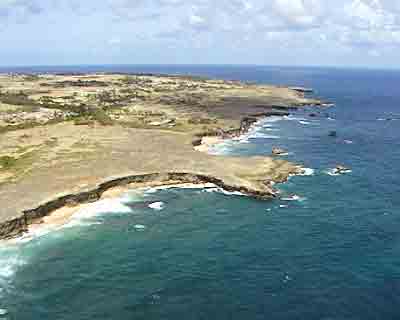|
General History of Barbados page 2 |
Artefacts and evidence point to settlement some time around 1623 B.C. - 1540 Amerindian Civilisation: The Arawaks were short, olive-skinned people who bound their foreheads during infancy to slope it into a point. They considered this along with black and white body painting to be attractive. The Ca¤ques (chiefs) and influential members of the tribe wore nose plugs and/or rings made of copper and gold alloys (History of Barbados). They were an agricultural people and grew cotton, cassava, corn, peanuts, guavas, and papaws (papaya). The cotton was woven and used for armbands and hammocks. Cassava was ground and grated to be made into casareep, a seasoning used in cooking. The Arawaks also used harpoons, nets, and hooks, to fish for food.
|
|
It was at this time that the island was named Los Barbados (bearded-ones) by the Portuguese explorer Pedro a Campos. It was so named, presumably, after the island's fig trees, which have a beard-like appearance. 1492 Spanish: Despite the Caribs' ruthless warlike abilities, the island was taken over by the Spanish in 1492. The Spanish brutally imposed slavery on the Caribs. Slavery and the contagious European small pox and tuberculosis ended the Caribs' existence (History of Barbados). Spain, however, passed Barbados over in favour of the larger Caribbean islands (History of European Overseas Exploration and Empires). This left the island open for anyone who wanted to colonise it. 1625 - 1644 English Colonisation: The first English ship touched the island on May 14th 1625 under the command of Captain John Powell. The island was therefore claimed on behalf of King James I. On February 17th 1627, Captain Henry Powell landed with a party of 80 settlers and 10 slaves to occupy and settle the island. This expedition landed in Holetown formerly known as Jamestown. The colonists established a House of Assembly in 1639. It was the 3rd ever Parliamentary Democracy in the world (Barbados History). People with good financial backgrounds and social connections with England were allocated land. Within a few years much of the land had been deforested to make way for tobacco and cotton plantations. During the 1630s, sugar cane was introduced to the agriculture. The production of sugar, tobacco and cotton was heavily reliant on the indenture of servants. White civilians who wanted to emigrate overseas could do so by signing an agreement to serve a planter in Barbados for a period of 5 or 7 years. To meet the labour demands, servants were also derived from kidnapping, and convicted criminals were shipped to Barbados. Descendants of the white slaves and indentured labour (referred to as Red Legs) still live in Barbados, they live amongst the black population in St. Martin's River and other east coast regions. At one time they lived in caves in this region. |
|
1644 - 1700 Sugar and Slavery: A potential market formed for slaves and sugar-making machinery by the Dutch Merchants who were to supply Barbados with their requirements of forced labour from West Africa. The slaves came from Sierra Leone, Guinea, Ghana, the Ivory Coast, Nigeria and Cameroon. Many slaves did not survive the journey from Africa, but many thousands still reached their destination. The Barbadians dominated the Caribbean Sugar Industry in these early years. The sugar plantation owners were powerful and successful businessmen who had arrived in Barbados in the early years. |
 |
|
Many natural disasters occurred in the late 1600s, such as the locust plague of 1663, the Bridgetown fire and a major hurricane in 1667. Drought in 1668 ruined some planters and excessive rain in 1669 added to their financial problems. However, investment continued in sugar and slaves and was perceived to have good prospects. By 1720 Barbadians were no longer a dominant force within the sugar industry. They had been surpassed by the Leeward Islands and the Jamaica. 1807 - 1838 Abolition, rebellion and
emancipation: After slavery was abolished in 1834, many of the new citizens of
Barbados took advantage of the superb education available on the island.
After these citizens had been educated, they wanted something more than
working in the cane fields. Some of them gained prominent offices in
Barbados. Others worked in common jobs, and still others stayed in the
cane fields (Barbados History). Many people were drawn to Barbados because of the climate and slow pace
of life. The island was thought of as a cure for "the vapours" (Barbados
History). Even Major George Washington visited the island with his
tuberculosis-stricken half brother in hope of ameliorating his illness
(Barbados History) Slavery, abolished in 1834, was followed by a 4-year apprenticeship
period during which free men continued to work a 45-hour week without pay
in exchange for living in the tiny huts provided by the plantation owners.
Freedom from slavery was celebrated in 1838 at the end of the
apprenticeship period with over 70,000 Barbadians of African descent
taking to the streets with the Barbados folk song: 1961-1966 Independence: Barbados was first occupied by the British in 1627 and remained a British colony until internal autonomy was granted in 1961. The Island gained full independence in 1966, and maintains ties to the Britain monarch represented in Barbados by the Governor General. It is a member of the Commonwealth. The first leader of Barbados as a free nation was the Right Honourable Errol Walton Barrow, of the Democratic Labour Party. The other major political party is the Barbados Labour Party, led by the current Prime Minister - The Right Honourable Owen Arthur. In 1989, the National Democratic Party was formed. Its leader was Dr.Richie Haynes. |
|
Activities
Barbados
Beaches
Calendar
Diving
Ecology
Exploring
Fun Facts
Geography
History
Home
Hotels
MDDM
Restaurants
& Nightlife
Tourism
Transport |